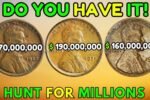The Rare Bicentennial Quarter Valued at $2.5 Billion, Still in Circulation
When it comes to rare coins, most people imagine them kept safely in a collector’s case or displayed in a museum. But what if we told you that a coin potentially worth $2.5 billion might still be lying unnoticed in someone’s pocket or piggy bank? Yes, we are talking about the famous Bicentennial Quarter – a special coin minted in 1976 to celebrate 200 years of American independence. Surprisingly, one rare version of this coin has become the center of attention in the coin-collecting world because of its unusual characteristics and unbelievably high value.
Let’s understand how a coin that looks so ordinary might be one of the most valuable items in the U.S. currency system.
What is the Bicentennial Quarter?
In 1976, to mark 200 years of American independence, the U.S. Mint released special edition coins including the quarter, half-dollar, and dollar coins. Among these, the Bicentennial Quarter featured a unique design on the reverse side, showing a Colonial drummer and a victory torch surrounded by 13 stars, representing the original colonies.
The coin was widely circulated, and millions were made, so most people don’t consider it rare. However, one specific variety of the Bicentennial Quarter is known to be extremely valuable due to a combination of its metal content, minting error, and historical uniqueness.
What Makes This Coin Worth $2.5 Billion?
Now, you might wonder, how can a 25-cent coin be worth billions? The answer lies in a mystery. According to collectors and experts, there is believed to be one prototype or error coin created during testing phases that was never officially released. This version might have been struck in pure silver or gold, or it may include a unique minting defect that makes it one-of-a-kind.
If such a coin exists and is found in near-perfect condition, collectors and museums around the world would be willing to pay an unimaginable amount—some even estimate up to $2.5 billion. So far, no one has publicly claimed to have it, but rumors suggest that it could still be circulating or hidden in a private collection.
Overview Table – Bicentennial Quarter At A Glance
| Feature | Details |
|---|---|
| Coin Name | Bicentennial Quarter (1776-1976) |
| Face Value | 25 Cents |
| Estimated Rare Value | Up to $2.5 Billion |
| Key Design Elements | Colonial Drummer, Torch, 13 Stars |
| Material (Standard) | Copper-Nickel |
| Rare Material Possibility | Silver or Experimental Alloy |
| Mint Mark | D (Denver), S (San Francisco), P (Philadelphia) |
| Reason for High Value | Rarity, Mint Error, Prototype |
| Public Circulation | Yes (Millions made) |
| Current Status | Possibly Still in Circulation |
How to Identify the Rare Version?
Finding the rare Bicentennial Quarter is like looking for a needle in a haystack, but not impossible. Here are some things to watch out for:
-
Weight & Sound: A rare coin made of a different metal may sound different when tapped or feel heavier.
-
Mint Mark: Some error coins lack a mint mark or show double stamping.
-
Shiny Finish: If your quarter has a very shiny, mirror-like surface, it might be a proof coin.
-
Error Signs: Off-center prints, unusual engravings, or incorrect dates may signal an error coin.
-
Unusual Color: A golden or silver shine (more than usual) might mean a different metal was used.
If you think you have something similar, don’t spend it! Get it checked by a professional coin appraiser.
Why is it Still in Circulation?
It sounds strange, but it’s very likely. Most people never check their coins closely. They just use them for purchases, vending machines, or throw them in a jar. This is how rare coins can easily slip through unnoticed.
Also, the government never confirmed if the billion-dollar coin was ever officially released or lost. So if someone unknowingly used it, it could now be sitting in someone else’s wallet or cash drawer.
The Rise of Coin Collecting
With news like this, more and more people are becoming interested in coin collecting. It’s no longer just a hobby for older generations—it’s a treasure hunt. Even common-looking coins might have hidden value if they have the right combination of errors, rarity, and history.
People are now taking a second look at their spare change, hoping to find something that could change their life forever.
What Should You Do If You Think You Found It?
-
Do Not Clean the Coin: Cleaning can damage the surface and reduce its value.
-
Check the Weight: Use a digital scale to see if it’s different from a normal quarter.
-
Compare Designs: Look for small differences in the design, mint marks, or font.
-
Get Expert Help: Contact a local coin dealer or send it to a grading agency like PCGS or NGC.
-
Secure It: Keep the coin safe in a pouch or holder until verified.
FAQs
Q1. Are all Bicentennial Quarters valuable?
No, most Bicentennial Quarters are common and only worth their face value. Only the rare prototype or error coin has extraordinary value.
Q2. How can I check if my coin is rare?
Examine the design closely, check for minting errors, and compare it with standard versions. A professional appraiser can help confirm its authenticity.
Q3. Why would a coin be worth $2.5 billion?
Because of extreme rarity, historical significance, and collector demand. If a coin is one-of-a-kind and has a mysterious backstory, collectors are willing to pay anything for it.
Q4. Can I sell such a coin online?
Yes, but it’s better to get it certified first. Selling through a trusted coin auction or dealer is safer and more profitable.
Q5. What happens if I spend it by mistake?
If you accidentally use a rare coin, the next person might just win the jackpot. That’s why it’s important to always check your change before spending.
Final Thoughts
A quarter worth $2.5 billion may sound unbelievable, but in the world of rare coins, anything is possible. The mystery surrounding the rare Bicentennial Quarter has turned it into a legend. Somewhere in the country, someone might be holding the most valuable coin in history without even knowing it.
So the next time you’re counting your change or digging through an old drawer, take a closer look—you just might be holding a billion-dollar treasure.



